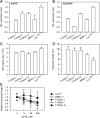Modification of Threonine-1050 of SlBRI1 regulates BR Signalling and increases fruit yield of tomato
- PMID: 31196007
- PMCID: PMC6567510
- DOI: 10.1186/s12870-019-1869-9
Modification of Threonine-1050 of SlBRI1 regulates BR Signalling and increases fruit yield of tomato
Abstract
Background: Appropriate brassinosteroid (BR) signal strength caused by exogenous application or endogenous regulation of BR-related genes can increase crop yield. However, precise control of BR signals is difficult and can cause unstable effects and failure to reach full potential. Phosphorylated BRASSINOSTEROID INSENSITIVE1 (BRI1), the rate-limiting receptor in BR signalling, transduces BR signals, and we recently demonstrated that modifying BRI1 phosphorylation sites alters BR signal strength and botanical characteristics in Arabidopsis. However, the functions of such phosphorylation sites in agronomic characteristics of crops remain unclear.
Results: In this work, we investigated the roles of tomato SlBRI1 threonine-1050 (Thr-1050). SlBRI1 mutant cu3-abs1 plants expressing SlBRI1 with a non-phosphorylatable Thr-1050 (T1050A), with a wild-type SlBRI1 transformant used as a control, were examined. The results showed enhanced autophosphorylation of SlBRI1 and BR signal strength for cu3-abs1 harbouring T1050A, which promoted yield through increased plant expansion, leaf area, fruit weight and fruit number per cluster but reduced nutrient contents, including ascorbic acid and soluble sugar levels. Moreover, plant height, stem diameter, and internodal distance were similar between the transgenic plants.
Conclusion: Our results reveal the biological role of Thr-1050 in tomato and provide a molecular basis for establishing high-yield crops by precisely controlling BR signal strength via phosphorylation site modification.
Keywords: Agronomic trait; BR signal; Phosphorylation site; SlBRI1; Tomato.
Conflict of interest statement
The authors declare that they have no competing interests.
Figures





Similar articles
-
Modification of Threonine-825 of SlBRI1 Enlarges Cell Size to Enhance Fruit Yield by Regulating the Cooperation of BR-GA Signaling in Tomato.Int J Mol Sci. 2021 Jul 18;22(14):7673. doi: 10.3390/ijms22147673. Int J Mol Sci. 2021. PMID: 34299293 Free PMC article.
-
Modification of Serine 1040 of SIBRI1 Increases Fruit Yield by Enhancing Tolerance to Heat Stress in Tomato.Int J Mol Sci. 2020 Oct 16;21(20):7681. doi: 10.3390/ijms21207681. Int J Mol Sci. 2020. PMID: 33081382 Free PMC article.
-
Enhanced brassinosteroid signaling intensity via SlBRI1 overexpression negatively regulates drought resistance in a manner opposite of that via exogenous BR application in tomato.Plant Physiol Biochem. 2019 May;138:36-47. doi: 10.1016/j.plaphy.2019.02.014. Epub 2019 Feb 23. Plant Physiol Biochem. 2019. PMID: 30844693
-
Brassinosteroid-mediated regulation of agronomic traits in rice.Plant Cell Rep. 2014 May;33(5):683-96. doi: 10.1007/s00299-014-1578-7. Epub 2014 Mar 26. Plant Cell Rep. 2014. PMID: 24667992 Free PMC article. Review.
-
Functional Specificities of Brassinosteroid and Potential Utilization for Crop Improvement.Trends Plant Sci. 2018 Nov;23(11):1016-1028. doi: 10.1016/j.tplants.2018.08.007. Epub 2018 Sep 13. Trends Plant Sci. 2018. PMID: 30220494 Review.
Cited by
-
Designed Manipulation of the Brassinosteroid Signal to Enhance Crop Yield.Front Plant Sci. 2020 Jun 11;11:854. doi: 10.3389/fpls.2020.00854. eCollection 2020. Front Plant Sci. 2020. PMID: 32595692 Free PMC article. Review.
-
Enhancing the medicinal properties and phytochemical content of bitter melon (Momordica charantia L.) through elicitation with brassinosteroid, ethrel, and carrageenan.BMC Plant Biol. 2024 Oct 16;24(1):967. doi: 10.1186/s12870-024-05688-z. BMC Plant Biol. 2024. PMID: 39407143 Free PMC article.
-
Recent Advances in Studying the Regulation of Fruit Ripening in Tomato Using Genetic Engineering Approaches.Int J Mol Sci. 2024 Jan 7;25(2):760. doi: 10.3390/ijms25020760. Int J Mol Sci. 2024. PMID: 38255834 Free PMC article. Review.
-
Activation loop phosphorylation of a non-RD receptor kinase initiates plant innate immune signaling.Proc Natl Acad Sci U S A. 2021 Sep 21;118(38):e2108242118. doi: 10.1073/pnas.2108242118. Proc Natl Acad Sci U S A. 2021. PMID: 34531323 Free PMC article.
-
SlCESTA Is a Brassinosteroid-Regulated bHLH Transcription Factor of Tomato That Promotes Chilling Tolerance and Fruit Growth When Over-Expressed.Front Plant Sci. 2022 Jul 14;13:930805. doi: 10.3389/fpls.2022.930805. eCollection 2022. Front Plant Sci. 2022. PMID: 35909777 Free PMC article.
References
-
- Clouse SD, Sasse JM. BRASSINOSTEROIDS: essential regulators of plant growth and development. Annu Rev Plant Physiol Plant Mol Biol. 1998;49:427–451. - PubMed
-
- Altmann T. Molecular physiology of brassinosteroids revealed by the analysis of mutants. Planta. 1999;208(1):1–11. - PubMed
-
- Clouse S. Brassinosteroids. Curr Biol. 2001;11(22):R904. - PubMed
-
- Haubrick LL, Assmann SM. Brassinosteroids and plant function: some clues, more puzzles. Plant Cell Environ. 2006;29(3):446–457. - PubMed
MeSH terms
Substances
Grants and funding
LinkOut - more resources
Full Text Sources
Other Literature Sources

